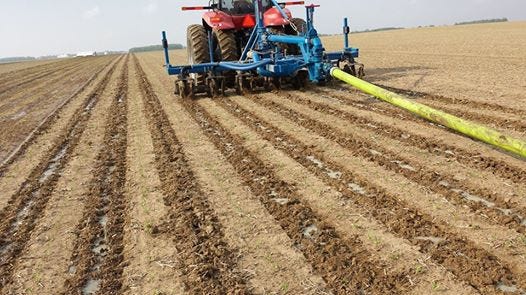
Think Different
When Ohio farmer Tom Harrod first heard about sidedressing hog manure he was skeptical. He went to a county extension program after talking to some farmers about their use of hog manure on growing corn, then he decided to give it a try. After achieving good yields without using commercial fertilizer, he became sold on the practice. Now, Harrod says, it’s driving profits in his operation.
-----
The idea to use hog manure on standing corn frightened Rossburg, Ohio farmer Tom Harrod at first. He has applied hog manure to fields, before and after crops, because they produce 12,000 hogs per year. He commonly used commercial fertilizer and soil testing for 30 years on their 1,300 acres that he farms with his son, Korey. But he knew a change was needed. That change was to utilize the nitrogen in the hog manure on a growing crop.
So Harrod began working with Ohio State University Manure Specialist Glenn Arnold and OSU Extension Agent Sam Custer to inject the hog manure as a sidedress in corn.
Manure replaces commercial fertilizer
“I admit, I didn’t think it would work,” says Harrod. Now, he thinks differently. “We don’t use commercial fertilizer on the fields where we inject hog manure, and we achieve the same yields or better than if we used commercial fertilizer.”
“This practice makes a lot of sense in these tough economic times,” adds Custer. He says farmers have success because injected nitrogen in the manure stays available longer for the corn plants; not reduced by rainfall or sunlight. Commercial fertilizer can be washed away by a rainstorm.
The hog manure application injection not only provides nitrogen for the corn crop but also has enough nutrients such as potash and phosphorus left over for the next year’s soybean crop. “The manure has the right amount of nutrient value to get two crops,” says Harrod.
The farm is now saving close to $100 an acre using manure over commercial fertilizer. Custer says the data collected shows the injection system has yielded a 20-25 bushel increase.
Switched application methods
Harrod says a key to success is injecting hog manure as the corn plants grow. The conventional idea of applying manure in the fall loses nitrogen. But by injecting it, the plant is able to use it and not lose it. He applies 6,000 gallons of manure per acre, with a value of about 30 pounds of nitrogen per 1,000 gallons.
When this sidedress research began, a tank was used but producers found compaction issues in their fields. Now they have switched to a dragline system, and there is no compaction. However, the hose does move across growing rows of corn. 
To reduce hose damage to growing corn, it’s all about injection timing. There is a short window when it can be applied. Too late and the draglines can break off the corn and it dies. After three years of application timing research by Ohio State, the researchers concluded that the hog manure has to be applied before the corn plants reach V4 or eight inches in height (see chart).
Custer says farmers interested in starting the practice must discuss critical application timing with their custom applicator. Once a farmer finds success, buying their own injector system may yield added benefits, especially timeliness.
For the Harrod operation, they normally run a hose one mile from the hog barns but can run it up to one mile and half. Some operations inject as far as two miles from the facility.
Concerns and BMPs
Custer says it is a sound practice to apply to a growing crop, but warns it is a liquid so there are precautions. One is to watch field tiles so that no damage is done to them. Another recommendation is to install tile control structures if possible. They can eliminate excess manure getting into creeks or ditches.
Another practice is to have a manure analysis completed. Know your nitrogen and phosphorus levels. Custer says most hog manure has an application rate of 13,000 gallons per acre. Farmers only need to apply 6,000 gallons per acre. He also urges producers to follow the 4R’s. Apply at the right time, the right place, the right source and at the right rate to ensure success.
About the Author(s)
You May Also Like




